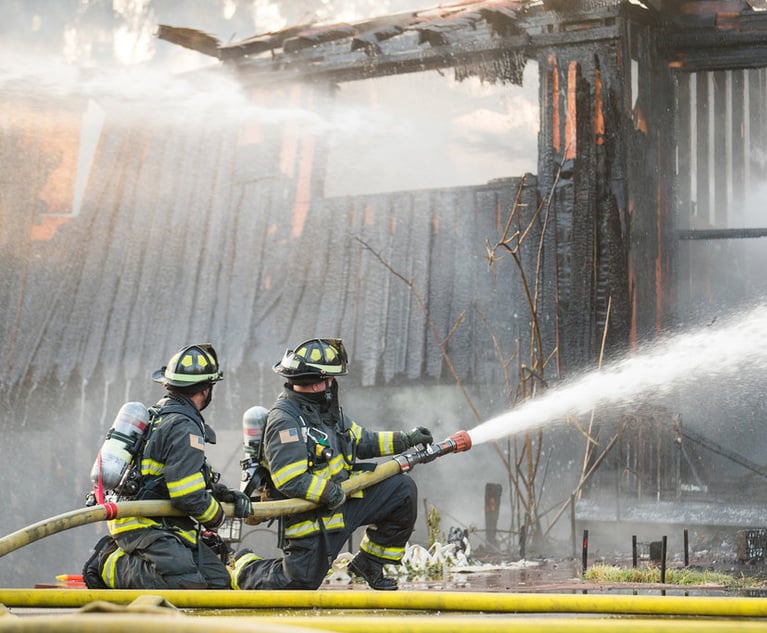Millennials Flocking to Texas Law Firms
An ALM Intelligence report found that 43 percent of lawyers at about 400 large firms are millennials. Five large Texas firms beat that average.
November 17, 2017 at 05:56 PM
31 minute read

This story is part of a series exploring how law firms and others in the legal industry are adapting to manage their millennial workers, from recruitment and real estate to training and technology and beyond. Read our overview here.
The youth movement is settling in at Texas firms, particularly at five large firms where millennials make up a higher-than-average percentage of each firm's lawyers.
Millennials account for 43 percent of lawyers at the nearly 400 large U.S. firms included in a report compiled by ALM Intelligence. Five large Texas firms exceed that 43 percent share of millennial lawyers, with Vinson & Elkins coming in with the highest percentage of millennial lawyers: 54 percent.
That means that more than half of the lawyers at V&E were born between 1981 and 1999, or are between the ages of 18 and 36.
V&E Chairman Mark Kelly, a partner in Houston, said he's not surprised that more than half of the firm's lawyers are 36 or younger, considering the Houston-based firm conducts consistent recruiting of first-year lawyers.

David Botter, hiring partner for Akin Gump Strauss Hauer & Feld, said the same applies to his firm, where millennials account for 47 percent of the lawyers. Akin Gump's lawyer population is refreshed every year, he said, with the firm each year bringing on about 50 new associates who came out of its summer program.
The other three Texas firms with more millennial lawyers than the national average are Susman Godfrey, with 49 percent; Baker Botts with 48 percent; and Haynes and Boone with 46 percent.
Strasburger & Price matched the national average with 43 percent, according to ALI data.
While millennials may soon account for half of all lawyers at the U.S. firms included in the ALI report, their power is probably less than their numbers would suggest, since 88 percent of them are associates and only 5 percent are partners. But as retirements—either voluntary or prompted by a mandatory retirement policy—slim the partnership ranks of lawyers who are older than millennials, that will change. Currently, Generation X, which describes lawyers age 37 to 52, accounts for 52 percent of partners, and baby boomers, who are age 53 to 71, make up 40 percent of partners. Lawyers who are even older make up 2 percent of partners at the firms in the report.
Houston and Dallas Firms Have Largest Percentage of Millennials
Broken down by city, millennials make up 42 percent of lawyers at large firms in Houston and 41 percent in Dallas. There are fewer in Austin and San Antonio.

Texas firms with large proportions of millennials differ in how the young lawyers influence firm operations.
Stephen Susman, founder of Susman Godfrey, said he didn't think about how his firm's lawyers fit into generational categories until a recent dinner with a New York University professor, who talked about the categories.
“We were talking about just how the world has changed. I'm the Silent Generation. My wife is a boomer. My children are Gen Xers,” Susman said, pointing out that a newer “generation” follows the millennials.
Millennials Have Impact on Firms
Susman said he did not realize until then that nearly half of the firm's lawyer are millennials, so it hasn't led to changes. “We treat them all, everyone, the same. It's probably why they are happy here,” he said.
In contrast, Botter, the Akin Gump hiring partner, said “talent development” is a priority, so the firm actively considers the sensibilities of younger lawyers, including millennials. He said firm management regularly sits down and talks to midlevel associates and first-years to learn what resonates with them and what the firm can do to enhance their development as a lawyer.
He said the firm is considering several new actions following a recent retreat with fourth-year lawyers, a group that falls solidly in the millennial category. The firm acted quickly on some of the concerns the midlevel associates discussed with Kim Koopersmith, the firm's chairperson, Botter said, such as providing each associate and senior associate (which the firm calls counsel) with a budget for business development. That's a departure from the norm, according to the findings of ALI's recent new partners survey, where nearly half of the new Texas partners who participated in the survey said their firm does not provide them with an individual budget for business development.
The firm also consults with younger lawyers, including young partners, about their technology needs, he said. They are “much more in tune with the advances in technology, constantly coming up with ideas on how they can improve their uses of technology, how they can make it easier to do their work,” he said.
In addition, Botter said that as a result of suggestions from younger lawyers, Akin Gump is working on a program to provide more frequent feedback to younger attorneys.
“We are trying to mix in another level of feedback on a major project basis, so people are getting real feedback in real time, rather than waiting for the end-of-the-year review,” he said.
V&E also recognizes that younger lawyers are more tech-savvy, said Kelly, the firm's chairman. He said younger lawyers are more comfortable with social media, and more likely to want to work off-site with supporting technology.
They also tend to be more mobile, he said, and are less likely than lawyers of his generation to stay at one firm for their whole career.
“Many of them will have several jobs,” Kelly said. “Our goal is to make sure we keep them and retain them.”
The V&E partner said firms need to accommodate millennial lawyers because the group will provide the next generation of leaders.
“One of the reasons I've been here so long is that the enthusiasm and the vibrancy of the younger generation motivate me,” he said.

This story is part of a series exploring how law firms and others in the legal industry are adapting to manage their millennial workers, from recruitment and real estate to training and technology and beyond. Read our overview here.
The youth movement is settling in at Texas firms, particularly at five large firms where millennials make up a higher-than-average percentage of each firm's lawyers.
Millennials account for 43 percent of lawyers at the nearly 400 large U.S. firms included in a report compiled by ALM Intelligence. Five large Texas firms exceed that 43 percent share of millennial lawyers, with
That means that more than half of the lawyers at V&E were born between 1981 and 1999, or are between the ages of 18 and 36.
V&E Chairman Mark Kelly, a partner in Houston, said he's not surprised that more than half of the firm's lawyers are 36 or younger, considering the Houston-based firm conducts consistent recruiting of first-year lawyers.

David Botter, hiring partner for
The other three Texas firms with more millennial lawyers than the national average are
While millennials may soon account for half of all lawyers at the U.S. firms included in the ALI report, their power is probably less than their numbers would suggest, since 88 percent of them are associates and only 5 percent are partners. But as retirements—either voluntary or prompted by a mandatory retirement policy—slim the partnership ranks of lawyers who are older than millennials, that will change. Currently, Generation X, which describes lawyers age 37 to 52, accounts for 52 percent of partners, and baby boomers, who are age 53 to 71, make up 40 percent of partners. Lawyers who are even older make up 2 percent of partners at the firms in the report.
Houston and Dallas Firms Have Largest Percentage of Millennials
Broken down by city, millennials make up 42 percent of lawyers at large firms in Houston and 41 percent in Dallas. There are fewer in Austin and San Antonio.

Texas firms with large proportions of millennials differ in how the young lawyers influence firm operations.
Stephen Susman, founder of
“We were talking about just how the world has changed. I'm the Silent Generation. My wife is a boomer. My children are Gen Xers,” Susman said, pointing out that a newer “generation” follows the millennials.
Millennials Have Impact on Firms
Susman said he did not realize until then that nearly half of the firm's lawyer are millennials, so it hasn't led to changes. “We treat them all, everyone, the same. It's probably why they are happy here,” he said.
In contrast, Botter, the
He said the firm is considering several new actions following a recent retreat with fourth-year lawyers, a group that falls solidly in the millennial category. The firm acted quickly on some of the concerns the midlevel associates discussed with Kim Koopersmith, the firm's chairperson, Botter said, such as providing each associate and senior associate (which the firm calls counsel) with a budget for business development. That's a departure from the norm, according to the findings of ALI's recent new partners survey, where nearly half of the new Texas partners who participated in the survey said their firm does not provide them with an individual budget for business development.
The firm also consults with younger lawyers, including young partners, about their technology needs, he said. They are “much more in tune with the advances in technology, constantly coming up with ideas on how they can improve their uses of technology, how they can make it easier to do their work,” he said.
In addition, Botter said that as a result of suggestions from younger lawyers,
“We are trying to mix in another level of feedback on a major project basis, so people are getting real feedback in real time, rather than waiting for the end-of-the-year review,” he said.
V&E also recognizes that younger lawyers are more tech-savvy, said Kelly, the firm's chairman. He said younger lawyers are more comfortable with social media, and more likely to want to work off-site with supporting technology.
They also tend to be more mobile, he said, and are less likely than lawyers of his generation to stay at one firm for their whole career.
“Many of them will have several jobs,” Kelly said. “Our goal is to make sure we keep them and retain them.”
The V&E partner said firms need to accommodate millennial lawyers because the group will provide the next generation of leaders.
“One of the reasons I've been here so long is that the enthusiasm and the vibrancy of the younger generation motivate me,” he said.
This content has been archived. It is available through our partners, LexisNexis® and Bloomberg Law.
To view this content, please continue to their sites.
Not a Lexis Subscriber?
Subscribe Now
Not a Bloomberg Law Subscriber?
Subscribe Now
NOT FOR REPRINT
© 2025 ALM Global, LLC, All Rights Reserved. Request academic re-use from www.copyright.com. All other uses, submit a request to [email protected]. For more information visit Asset & Logo Licensing.
You Might Like
View All

Sunbelt Law Firms Experienced More Moderate Growth Last Year, Alongside Some Job Cuts and Less Merger Interest
4 minute read
Once the LA Fires Are Extinguished, Expect the Litigation to Unfold for Years
5 minute read
Trending Stories
- 1Considerations for Establishing or Denying a Texas Partnership to Invest in Real Estate
- 2In-House AI Adoption Stalls Despite Rising Business Pressures
- 3Texas Asks Trump DOJ to Reject Housing Enforcement
- 4Ideas We Should Borrow: A Legislative Wishlist for NJ Trusts and Estates
- 5Canadian Private Equity Firms Are Eyeing Tech Sector
Who Got The Work
J. Brugh Lower of Gibbons has entered an appearance for industrial equipment supplier Devco Corporation in a pending trademark infringement lawsuit. The suit, accusing the defendant of selling knock-off Graco products, was filed Dec. 18 in New Jersey District Court by Rivkin Radler on behalf of Graco Inc. and Graco Minnesota. The case, assigned to U.S. District Judge Zahid N. Quraishi, is 3:24-cv-11294, Graco Inc. et al v. Devco Corporation.
Who Got The Work
Rebecca Maller-Stein and Kent A. Yalowitz of Arnold & Porter Kaye Scholer have entered their appearances for Hanaco Venture Capital and its executives, Lior Prosor and David Frankel, in a pending securities lawsuit. The action, filed on Dec. 24 in New York Southern District Court by Zell, Aron & Co. on behalf of Goldeneye Advisors, accuses the defendants of negligently and fraudulently managing the plaintiff's $1 million investment. The case, assigned to U.S. District Judge Vernon S. Broderick, is 1:24-cv-09918, Goldeneye Advisors, LLC v. Hanaco Venture Capital, Ltd. et al.
Who Got The Work
Attorneys from A&O Shearman has stepped in as defense counsel for Toronto-Dominion Bank and other defendants in a pending securities class action. The suit, filed Dec. 11 in New York Southern District Court by Bleichmar Fonti & Auld, accuses the defendants of concealing the bank's 'pervasive' deficiencies in regards to its compliance with the Bank Secrecy Act and the quality of its anti-money laundering controls. The case, assigned to U.S. District Judge Arun Subramanian, is 1:24-cv-09445, Gonzalez v. The Toronto-Dominion Bank et al.
Who Got The Work
Crown Castle International, a Pennsylvania company providing shared communications infrastructure, has turned to Luke D. Wolf of Gordon Rees Scully Mansukhani to fend off a pending breach-of-contract lawsuit. The court action, filed Nov. 25 in Michigan Eastern District Court by Hooper Hathaway PC on behalf of The Town Residences LLC, accuses Crown Castle of failing to transfer approximately $30,000 in utility payments from T-Mobile in breach of a roof-top lease and assignment agreement. The case, assigned to U.S. District Judge Susan K. Declercq, is 2:24-cv-13131, The Town Residences LLC v. T-Mobile US, Inc. et al.
Who Got The Work
Wilfred P. Coronato and Daniel M. Schwartz of McCarter & English have stepped in as defense counsel to Electrolux Home Products Inc. in a pending product liability lawsuit. The court action, filed Nov. 26 in New York Eastern District Court by Poulos Lopiccolo PC and Nagel Rice LLP on behalf of David Stern, alleges that the defendant's refrigerators’ drawers and shelving repeatedly break and fall apart within months after purchase. The case, assigned to U.S. District Judge Joan M. Azrack, is 2:24-cv-08204, Stern v. Electrolux Home Products, Inc.
Featured Firms
Law Offices of Gary Martin Hays & Associates, P.C.
(470) 294-1674
Law Offices of Mark E. Salomone
(857) 444-6468
Smith & Hassler
(713) 739-1250






